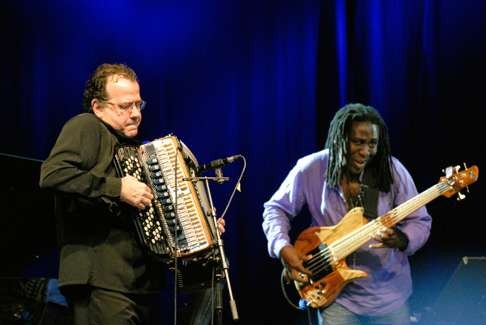
Hong Kong welcomes return of accordionist Richard Galliano
French multi-instrumentalist is known in Hong Kong as a jazz musician but this time he’s playing classical pieces with the City Chamber Orchestra
Richard Galliano is a multi-instrumentalist who plays the piano, trombone and accordion. But it is with the “squeeze-box” that the 65-year-old French musician had found his voice as an improviser.
Galliano is best known as a jazz musician. He last appeared in Hong Kong in 2009 at the Hong Kong International Jazz Festival, but for his latest outing, which is part of this year’s Le French May on June 10, he will be a classical soloist with the City Chamber Orchestra of Hong Kong.

“I have the same attitude as a music lover. I listen to Chet Baker, then to Mozart, to end up with Stevie Wonder. I also love silence and the sounds of nature.”


The upcoming concert will feature him playing Vivaldi’s Four Seasons, and Astor Piazzolla’s Concerto for Bandoneon – also called Aconcagua, after the Andean mountain. He has recorded both pieces.
Although he has taken the accordion into hitherto unexplored territory in both jazz and classical music, Galliano stresses that when he plays with classical ensembles he sticks faithfully to the scores.
“I play the original pieces for violin, clarinet, voice, cello, organ, harpsichord, flute, oboe, and even glass harmonica. Of course the accordion did not exist at the time of Bach or Vivaldi or Mozart [the instrument dates back to the early 19th century]. I am playing the lead score, but there is no adaptation,” he says.
For Four Seasons Galliano’s accordion will replace the solo violin part, but he learned the Concerto for Bandoneon on the instrument for which it was composed.
The bandoneon is German in origin, but most popular in South America. Like the accordion it is a member of the ‘free reed aerophone’ family of instruments, which, Galliano points out, have a Chinese antecedent in the ancient sheng.
The accordion, of course, has a piano style keyboard, but the bandoneon has an entirely different fingering system, related more closely to the smaller concertina, although involving many more buttons. There are as many as 71 on some South American instruments.
Furthermore the bandoneon exists in both chromatic and diatonic versions. Musicians trained on piano keyboards usually find either difficult to master. Galliano, who plays both, says he found the process of learning them entirely natural.
The bandoneon plays a prominent role in the tango music of Argentina, with which Galliano has a strong affinity.
The Argentinian composer and bandoneon player Astor Piazzola, who died in 1992 and who Galliano met for the first time in 1980, was a mentor, and he has recorded much of his “nuevo tango” music.
“Astor Piazzolla was my guide, my adviser, my friend,” he says.
“He wrote only one single Concerto for Bandoneon as a big tango for concert performance.”

Galliano has played it often, and made it his own.
“Today this concerto is part of me, of my own body. I can stay six months without playing the bandoneon and still play it in my head, by heart,” he says.
The concerto presents a number of challenges for soloist and orchestra.
“The first time I played this concerto, I had difficulties following the orchestra, but then I understood it was the bandoneon and myself who needed to show the way,” he says.
Tango is first and foremost music for dancing, and he stresses that the musicians have to remember that, even in a concert performance for a seated audience.
“All the orchestra needs to be ingrained with this rhythm of a milonga [Argentinian/Uruguayan musical genre]. We need to choose the tempi in relation to the dance. Let’s imagine a couple of dancers doing some tango figures. This excludes super fast tempi. It is not a musical piece for virtuosi but rather a piece that has a genre, a style. It must be performed with a rhythmic sense of tango very rubato,” he says.
He feels a strong emotional connection to the concerto partly because he knew the composer so well.
“Each time I play this concerto, I think of Astor. It is like a resurrection for the time of the show. I feel he is living inside me,” he says.
Richard Galliano with the City Chamber Orchestra of Hong Kong, City Hall Concert Hall, 5 Edinburgh Place, Central.
June 10, 8pm. HK$200, HK$300 and HK$400. Inquiries 2864 2156

